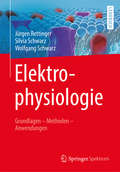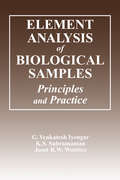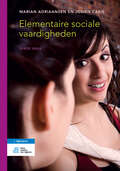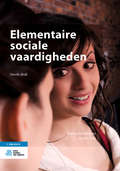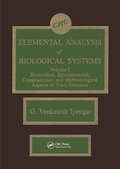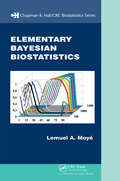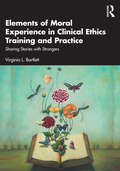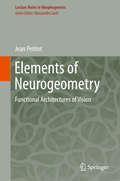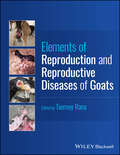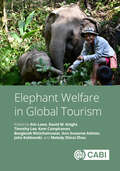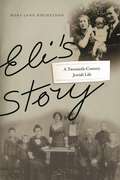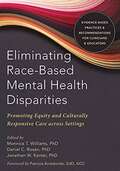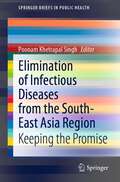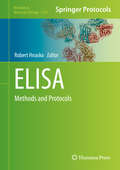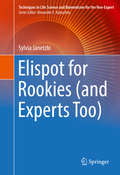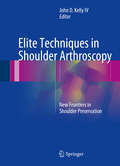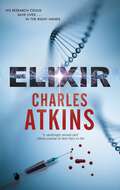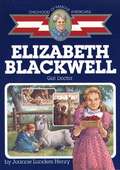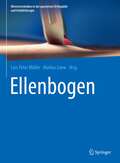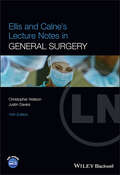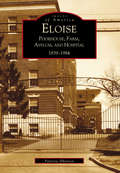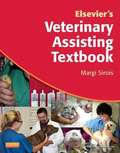- Table View
- List View
Elektrophysiologie: Grundlagen - Methoden - Anwendungen
by Wolfgang Schwarz Jürgen Rettinger Silvia SchwarzDieses Lehrbuch bietet einen umfassenden Überblick zur zellulären Elektrophysiologie. Die Themen reichen von bioelektrischen Phänomenen, die schon im antiken Ägypten beschrieben wurden, bis hin zu aktuellen Streitfragen wie der Gefahr durch Elektrosmog. Dieses kurz und prägnant geschriebene Werk beschreibt wissenschaftlich präzise verschiedene Methoden und Anwendungen der Elektrophysiologie sowie die biophysiologischen Grundlagen von Ionenkanälen und Carrier-Proteinen. Zahlreiche sorgsam ausgewählte Illustrationen und Grafiken ergänzen das Geschriebene, während Fragen am Ende jedes Kapitels dem Leser die Möglichkeit zur Selbstkontrolle bieten. Jeder Abschnitt enthält zudem Verweise auf relevante Publikationen und Literaturstellen, die für ein tieferes Verständnis zu Rate gezogen werden können. Das Buch stellt somit eine wertvolle Informationsquelle für Studierende der Biologie, Chemie und Physik dar, die sich speziell für Biophysik interessieren.
Element Analysis of Biological Samples: Principles and Practices, Volume II
by K. S. Subramanian G. Venkatesh Iyengar Joost R.W. WoittiezDespite the development of innovative new analytical techniques for biological trace element research, today's trace element investigators face formidable obstacles to obtaining reliable data. This complete reference identifies and assesses the challenges the analyst encounters at each stage of an analysis, and discusses the effects of various techniques on the sample.Three internationally recognized scientists and authors consider the effects of the numerous collection, storage, and sample preparatory techniques used in sample analysis. Proper analytical quality control, including such critical factors as sampling and sample preparation, specimen preservation and storage, and ashing, is examined. The book also looks at sample preparation methods unique to various instruments and speciation chemistry issues, and examines the link between chemical analysis and specimen banking. A previously unrecognized source of error, presampling factors, is also discussed.
Elementaire sociale vaardigheden: Transferpunt Vaardigheidsonderwijs
by Marian Adriaansen Josien CarisCommuniceren is een belangrijk onderdeel van vrijwel elk beroep. Of communicatieprocessen effectief verlopen is niet alleen afhankelijk van aan te leren technieken, maar vooral ook van de 'echtheid' van iemands optreden. Om effectief te kunnen communiceren heb je (zelf)kennis nodig over je eigen kwaliteiten. Dit leermateriaal helpt je om de basisvaardigheden zo aan te leren dat zij kunnen dienen als solide basis voor de ontwikkeling van je specifieke beroepsvaardigheden. De auteurs besteden in de hoofdstukken op oriënterend niveau ook aandacht aan de toepassing van de basisvaardigheden in verschillende hulpverleningssituaties binnen welzijn en gezondheidszorg. Nieuw is de website met daarop een serie filmfragmenten waarin de besproken vaardigheden worden gedemonstreerd. Op deze website zijn ook toetsvragen, studieopdrachten en oefeningen opgenomen, die een actieve wijze van kennismaken met en oefenen van de beoogde vaardigheden mogelijk maken. Aan deze geheel herziene druk zijn twee nieuwe hoofdstukken toegevoegd: Argumenteren en Digitaal communiceren. Waar vele boeken vooral ingaan op de theorie, is dit boek ook erg praktijkgericht. Het geeft studenten goede handvatten om theorie toe te passen en te oefenen, waardoor het boek meer is dan alleen een verdiepend boek.
Elementaire sociale vaardigheden: Transferpunt Vaardigheidsonderwijs
by Marian Adriaansen Josien CarisDit boek helpt studenten in zorg en welzijn om communicatieve basisvaardigheden zó aan te leren dat die een solide basis vormen voor de ontwikkeling van specifieke beroepsvaardigheden. Ook leren ze om die communicatieve vaardigheden in verschillende hulpverleningssituaties toe te passen. Daarbij heeft het boek aandacht voor aan te leren technieken, én voor de echtheid van iemands optreden. Effectief communiceren vereist immers ook kennis over je eigen kwaliteiten. Elementaire sociale vaardigheden gaat uitgebreid in op de theorie, én is erg praktijkgericht. Het s een verdiepend boek, dat studenten handvatten geeft om theorie te oefenen en toe te passen. Aan deze geheel herziene druk is bovendien een nieuw hoofdstuk toegevoegd: omgaan met laaggeletterdheid. Ook nieuw is de mogelijkheid om met behulp van een app direct vanuit het boek de bijpassende filmfragmenten te bekijken. In deze filmfragmenten worden de besproken vaardigheden gedemonstreerd. Ze staan ook op mijn.bsl.nl - net als de toetsvragen, studieopdrachten en oefeningen. Zo kun je eenvoudig kennismaken met de beoogde vaardigheden, en ze actief oefenen.
Elemental Analysis of Biological Systems: Biological, Medical, Environmental, Compositional, and Methodological Aspects, Volume I
by G. Venkatesh IyengarThe purpose of this volume is to emphasize the fact that biological trace element research is a multidisciplinary science which requires a prudent combination of biological insight and analytical awareness. The text frequently stresses that accurate measurements on biologically and analytically "valid" samples hold the key for success in future investigations. It reminds the analytical scientists and the life sciences researchers that their perceptions should extend beyond conventional limits - namely, the former as generators of data and the latter as interpreters of those findings. This book enables the reader to understand the intricacies of elemental composition studies in biological systems, and also provides a valuable source of information to biologists, biochemists, physicians, nutritionists and related scientific workers who intend to draw meaningful conclusions from the analytical findings.
Elementary Bayesian Biostatistics (Chapman & Hall/CRC Biostatistics Series)
by Lemuel A. MoyeBayesian analyses have made important inroads in modern clinical research due, in part, to the incorporation of the traditional tools of noninformative priors as well as the modern innovations of adaptive randomization and predictive power. Presenting an introductory perspective to modern Bayesian procedures, Elementary Bayesian Biostatistics explo
Elements of Moral Experience in Clinical Ethics Training and Practice: Sharing Stories with Strangers
by Virginia L. BartlettElements of Moral Experience in Clinical Ethics Training and Practice: Sharing Stories with Strangers is a philosophical and professional memoir of the education, training, and professional development of becoming a clinical ethics consultant. Utilizing a phenomenological and narrative lens, this book offers a fresh and energizing window into the field of healthcare ethics by pairing compelling clinical narratives of what it is like to do clinical ethics consultation with clear reflections and accessible introductions to key philosophical, professional, and humanistic roots for responsible practice. Each chapter contains a firsthand account of a clinical ethics encounter – with vivid detail, verbatim dialogue, and internal monologues that reveal the consultant’s reflections throughout the consultation. Following or at times woven into the clinical story, each chapter explores elements of practice by highlighting philosophical, professional, and humanistic resources that connect to and shape meaning in everyday clinical ethics work, drawing from phenomenologically and narratively oriented ethicists (Richard Zaner, Andrea Frolic, Mark Bliton, and Stuart Finder), influential thinkers in adjacent fields (Alfred Schutz, Kurt Wolff, and Pierre Bourdieu), and creative writers and artists (Barry Lopez, Joe Henry, Audre Lorde, Robert M. Pirsig, and Dar Williams). The innovative structure signposts and illustrates distinct elements of clinical ethics experience and practice, inviting the reader to move through the book in different ways, according to their own learning goals, as graduate students, advanced trainees, practicing clinical ethicists, or ethics educators. By focusing on themes identified in the unique instances or experiences of first-hand accounts, or by tracing the philosophical reflections on grounding and orienting texts from the field, readers can access different elements of clinical ethics practice while the book as a whole models a process for considering and interrogating these elements. Elements of Moral Experience in Clinical Ethics Training and Practice: Sharing Stories With Strangers invites readers to articulate, reflect on, share, and ultimately learn from their own experiences in clinical ethics consultation.
Elements of Neurogeometry
by Jean PetitotThis book describes several mathematical models of the primary visual cortex, referring them to a vast ensemble of experimental data and putting forward an original geometrical model for its functional architecture, that is, the highly specific organization of its neural connections. The book spells out the geometrical algorithms implemented by this functional architecture, or put another way, the "neurogeometry" immanent in visual perception. Focusing on the neural origins of our spatial representations, it demonstrates three things: firstly, the way the visual neurons filter the optical signal is closely related to a wavelet analysis; secondly, the contact structure of the 1-jets of the curves in the plane (the retinal plane here) is implemented by the cortical functional architecture; and lastly, the visual algorithms for integrating contours from what may be rather incomplete sensory data can be modelled by the sub-Riemannian geometry associated with this contact structure. As such, it provides readers with the first systematic interpretation of a number of important neurophysiological observations in a well-defined mathematical framework. The book's neuromathematical exploration appeals to graduate students and researchers in integrative-functional-cognitive neuroscience with a good mathematical background, as well as those in applied mathematics with an interest in neurophysiology.
Elements of Reproduction and Reproductive Diseases of Goats
by Tanmoy RanaSpecialist reference and practical guidebook on goat reproductive health, emphasizing reproductive diseases, their clinical management, and production management Elements of Reproduction and Reproductive Diseases of Goats discusses the reproductive system and various reproductive diseases of goats, with coverage of pathogenesis of diseases, disease prevention, diagnosis, and treatment via drugs and other methods, along with general best management of goats. To aid in reader comprehension and practical application, the book includes colored figures, lined figures, and tables visualizing key concepts. The book explains reproductive anatomy of both males and females in a systematic way. The main topics in this book include breeding characteristics, pregnancy detection, diagnosis, and treatment, management of infertility, obstetrics, abortion, surgery of the reproductive tract, and care and management of kids. The book emphasizes state-of-the-art research on the physiological and biochemical mechanisms in regulation of reproduction. Edited by a highly qualified practitioner and contributed to by a wide variety of contributors, each with specialized knowledge in their respective area of knowledge, Elements of Reproduction and Reproductive Diseases of Goats covers sample topics such as: Puberty and sexual maturity, selection criteria, nutrition, parasitic infection, seasonal perspectives, and estrus synchronizationPreparation for breeding season, gestation and parturition, lactation, reproductive failures, and postpartum careDiseases of the glans penis and prepuce, urethra, scrotum and inguinal lymph nodes, prostate, and testisInfectious abortive diseases, including chlamydiosis, toxoplasmosis, q fever, brucellosis, and campylobacteriosis, along with non-infectious abortive diseasesKetosis and pregnancy toxemia, hypocalcemia, uterine and rectal prolapse, retained placenta and fetal membranes, metritis and endometritis, pyometra, and mastitis Elements of Reproduction and Reproductive Diseases of Goats is a highly comprehensive resource on the subject ideal for veterinary practitioners, small ruminant researchers, veterinary students, farm managers, industrialists, and all professionals involved in the raising, care, and breeding of goats, along with students and instructors in related programs of study.
Elephant Welfare in Global Tourism
At the centre of the elephant tourism industry lie two profound challenges: the delicate balance between income and compassion, and the severe threats to the survival of all remaining elephant species. Trained elephants exchange hands for staggering sums, reaching up to $100,000 each, yet the colossal appetites of the herds, with each elephant devouring over 100 kilograms of sustenance daily, pose formidable economic challenges for camp owners. An elephant camp's revenue is dependent on tourism, with a complex web of specialist businesses, local and international, large and small, contracted to recruit and enable visitors. This results in competition focused mainly on price and profitability considerations. The inadequacies of these business networks and of the administrative controls within which they operate were demonstrated during the complete shutdown of elephant tourism venues in early 2020 due to COVID-19. This authoritative text analyses elephants' vulnerabilities, providing an inspiring call to action for a more compassionate coexistence between elephants and the stakeholders responsible for their individual and herd welfare and survival. Elephant Welfare in Global Tourism is intended for managers, professionals and administrators of elephant camps, refuges and rescue centres, and for NGOs providing advice and support. Academic researchers on wildlife may find inspiration for suitable topics, and examples of current methodologies.
Eli's Story: A Twentieth-Century Jewish Life
by Meri-Jane RochelsonEli’s Story: A Twentieth-Century Jewish Life is first and foremost a biography. Its subject is Eli G. Rochelson, MD (1907–1984), author Meri-Jane Rochelson’s father. At its core is Eli’s story in his own words, taken from an interview he did with his son, Burt Rochelson, in the mid-1970s. The book tells the story of a man whose life and memory spanned two world wars, several migrations, an educational odyssey, the massive disruption of the Holocaust, and finally, a frustrating yet ultimately successful effort to restore his professional credentials and identity, as well as reestablish family life. Eli’s Story contains a mostly chronological narration that embeds the story in the context of further research. It begins with Eli’s earliest memories of childhood in Kovno and ends with his death, his legacy, and the author’s own unanswered questions that are as much a part of Eli’s story as his own words. The narrative is illuminated and expanded through Eli’s personal archive of papers, letters, and photographs, as well as research in institutional archives, libraries, and personal interviews. Rochelson covers Eli’s family’s relocation to southern Russia; his education, military service, and first marriage after he returned to Kovno; his and his family’s experiences in the Dachau, Stutthof, and Auschwitz concentration camps—including the deaths of his wife and child; his postwar experience in the Landsberg Displaced Persons (DP) camp, and his immigration to the United States, where he determinedly restored his medical credentials and started a new family. Rochelson recognizes that both the effort of reconstructing events and the reality of having personal accounts that confirm and also differ from each other in detail, make the process of gap-filling itself a kind of fiction—an attempt to shape the incompleteness that is inherent to the story. In the epilogue, the author reminds readers that the stories of lives don’t have clear chronologies. They go off in many directions, and in some ways they never end. An earlier reviewer said of the book, "Eli’s Story combines the care of a scholar with the care of a daughter." Both scholars and general readers interested in Holocaust narratives will be moved by this monograph.
Eli, The Boy Who Hated to Write: Understanding Dysgraphia (2nd Edition)
by Eli I. Richards Regina RichardsA book that challenges all to an emotional connection to children suffering from dysgraphia. It discusses the issues associated with it and the children's experiences; continually providing teachers, parents with additional information on the same as they are the cores in helping the kids get through by understanding their issues for them to grow academically and professionally.
Eliminating Race-based Mental Health Disparities: Promoting Equity And Culturally Responsive Care Across Settings
by Jonathan W. Kanter Monnica T. Williams Daniel C. RosenEliminating Race-Based Mental Health Disparities offers concrete guidelines and evidence-based best practices for addressing racial inequities and biases in clinical care. Perhaps there is no subject more challenging than the intricacies of race and racism in American culture. More and more, it has become clear that simply teaching facts about cultural differences between racial and ethnic groups is not adequate to achieve cultural competence in clinical care. One must also consider less “visible” constructs—including implicit bias, stereotypes, white privilege, intersectionality, and microaggressions—as potent drivers of behaviors and attitudes. In this edited volume, three leading experts in race, mental health, and contextual behavior science explore the urgent problem of racial inequities and biases, which often prevent people of color from seeking mental health services—leading to poor outcomes if and when they do receive treatment. In this much-needed resource, you’ll find evidence-based recommendations for addressing problems at multiple levels, and best practices for compassionately and effectively helping clients across a range of cultural groups and settings. As more and more people gain access to services that have historically been unavailable to them, guidelines for cultural competence in clinical care are needed. Eliminating Race-Based Mental Health Disparities offers a comprehensive road map to help you address racial health disparities and improve treatment outcomes in your practice.
Elimination of Infectious Diseases from the South-East Asia Region: Keeping the Promise (SpringerBriefs in Public Health)
by Poonam Khetrapal SinghThis book discusses the historical context, country experience, and best practices that led to eliminating infectious diseases from the WHO’s South-East Asia Region, such as malaria, lymphatic filariasis, yaws, trachoma, and mother-to-child HIV in the mid-twentieth and twenty-first century. The UN Sustainable Development Goals (3.3) targets to end AIDS, tuberculosis, malaria, and neglected tropical diseases and combat hepatitis, water-borne diseases and other communicable diseases by 2030. In this context, this book is of high significance to countries from the SEA region and around the globe. It helps create national strategies and action plans on infectious disease elimination and thus attaining SDG 3.3.
Elisa
by Robert HnaskoThis volume is a practical biochemical guide to the Enzyme-Linked Immunosorbent Assay (ELISA), used to detect a target substance in a liquid sample. The ELISA is an important and widely used diagnostic tool in medicine, animal health, botany and quality assurance processes in food and beverage production. An introductory chapter orients the reader on the basic structure and function of immunoglobulins and their fragments while subsequent chapters outline the methodology to generate monoclonal antibodies using hybridoma technology and the general methods used to purify antibodies. Multiple chapters demonstrate how to creatively use the properties of the antibody to identify, localize and quantify target analytes to answer questions and resolve problems. The reader will learn how to use a variety of immunoassay strategies, reporters and detection systems that will undoubtedly facilitate their efforts to gain answers to their own questions. Written in the successful Methods in Molecular Biology series format, chapters include introductions to their respective topics, lists of the necessary materials and reagents, step-by-step, readily reproducible protocols and notes on troubleshooting and avoiding known pitfalls. Authoritative and easily accessible, ELISA: Methods and Protocols seeks to provide both professionals and novices with the technical information necessary for the reader to successfully use the immunoassay as part of the discovery process.
Elispot for Rookies (and Experts Too)
by Sylvia JanetzkiThis book provides basic, simple, and logical explanations for choices to be made to run the best Elispot possible. It allows the newcomer to truly understand the best options for specific protocol steps, reagents and materials, and provides even the experienced Elispot user with insight into best practices. The techniques presented here are supported by the author's twenty-plus years of first-hand experience working with this assay, as well as the shared experiences of numerous colleagues and collaborators. The enzyme-linked immunospot (Elispot) assay is a widely used technique to monitor cells on the single cell level for the release of analytes like cytokines, chemokines or immunoglobulins (antibodies), in response to particular stimuli. The most important feature of Elispot is its outstanding sensitivity, allowing the detection of specific cells in very low frequencies. The advantages of Elispot have resulted in it being widely adapted for use in research and translational applications in numerous fields including cancer, infectious diseases, autoimmunity, and transplantation.
Elite Techniques in Shoulder Arthroscopy
by John D. KellyIdeal for shoulder surgeons who want to upgrade their skills to the next level, this practical, step-by-step text presents the latest cutting-edge management strategies and science aimed at shoulder preservation surgery. Highlighting four main areas - the overhead athlete, shoulder instability, glenohumeral arthritis, and the rotator cuff - these innovative techniques focus on the maintenance of the native shoulder joint. Chapters open with an introduction to the clinical problem, followed by misgivings related to open surgery or arthroplasty as treatment strategies. A rationale for the arthroscopic treatment is then presented, along with an in-depth description of the technique itself as well as preliminary results. Techniques presented include posterior capsule release for the overhead athlete, arthroscopic Latarjet for instability, the CAM procedure for glenohumeral arthritis, biological augmentation for rotator cuff repair. A fifth section covers post-operative care and return-to-play considerations. With contributions from many of the top thinkers and surgeons of the shoulder, Elite Techniques in Shoulder Arthroscopy brings these exciting new management strategies to the fore with the aim of elevating them to more common practice for orthopedic surgeons and sports medicine specialists.
Elites, Policies and State Reconfiguration: Transforming the French Welfare Regime (International Series on Public Policy)
by William Genieys Mohammad-Saïd DarvicheThis book examines the history of the French welfare state from the mid-twentieth century to the present day. The French social security system has changed profoundly over the last few decades. The Bismarkian model of governance and social protection inherited from the Second World War has progressively faded away in favor of a reinforcement of the state’s capacity to intervene on policies and the implementation of national health insurance coverage. In order to understand this major transformation, this book draws on rich original sources to offer a historical and sociological perspective on elite policymakers and policy change. In doing so, it identifies correlations between the changing social backgrounds and career paths of elites in charge of social insurance policies since the 1940s, and the development of health policy programs. It will appeal to all those interested in public policy, health policy, social studies and French history and politics.
Elixir
by Charles AtkinsDr Frank Garfield has found a cure for cancer, but cut-throat businesses are looking to profit on the research and don't care who they trample over to do so. Paediatric oncologist Dr Frank Garfield has discovered a genetic cure for cancer that can save his young patients. But his mentor, Nobel Prize laureate Dr Jackson Atlas, believes his research is like blood in the water for profit-hungry drug companies that will twist and weaponize it. UNICO Pharmaceuticals CEO Leona Lang is desperate to find a new product, and Frank's formula could be the answer. But Jackson is an obstacle. Dalton Lang, Leona's sociopathic son, has been tasked with seducing Frank into joining UNICO. His first steps are to eliminate Jackson and make it look like a burglary. With Jackson gone, will Frank be persuaded to join UNICO or let his research, which could blow apart the cancer industry, die? The lives of innocent children hang in the balance. Frank can save them . . . but at what cost?
Elixir
by Gary BraverWhen biologist Chris Bacon headed for the unspoiled rainforests of Papua New Guinea in search of medicinal plants, he had no idea that he would bring home a rare flower rumored by a tribal shaman to prevent human aging. Driven by fountain-of-youth dreams, he plans to turn the flower into an elixir of youth and health.But as Chris begins tampering with the ultimate secret of nature, he unleashes forces that not only threaten his own family, but expose the world to unimaginably horrific consequences.At the Publisher's request, this title is being sold without Digital Rights Management Software (DRM) applied.
Elizabeth Blackwell: Girl Doctor
by Joanne Landers HenryThe life of the first woman doctor in the Unites States, who worked in England and America to open the field of medicine to women.
Ellenbogen (Meistertechniken in der operativen Orthopädie und Unfallchirurgie)
by Markus Loew Lars Peter MüllerDie Buchreihe „Meistertechniken in der operativen Orthopädie und Unfallchirurgie“ erlaubt es dem operativ tätigen Orthopäden und Unfallchirurgen, den Autoren - alle sind Meister ihres Faches - beim Operieren direkt über die Schulter zu schauen. Beschrieben werden häufige, aber erfahrungsgemäß schwierige Probleme und Techniken so, dass der erfahrene, aber im jeweiligen Gebiet nicht hochspezialisierte Operateur den behandelten Eingriff mit höherer Sicherheit auszuführen vermag. Alle Beschreibungen lassen sich direkt in die Praxis umsetzen: die Operationsverfahren werden step-by-step dargestellt und mit zahlreichen Fotos und brillanten Grafiken visualisiert.Initiiert und begleitet wird die Reihe durch Prof. Dr. med. D. Kohn und Prof. Dr. med. T. Pohlemann. Herausgeber des vorliegenden 5. Bandes Ellenbogen sind Prof. Dr. med. L. Müller und Prof Dr. med. M. Loew.
Ellis and Calne's Lecture Notes in General Surgery (Lecture Notes)
by Justin Davies Christopher WatsonEllis and Calne’s Lecture Notes in GENERAL SURGERY Ellis and Calne’s Lecture Notes in General Surgery Ellis and Calne’s Lecture Notes in General Surgery is a comprehensive guide that focuses on the fundamentals of general surgery while systematically covering all the clinical surgical problems that a student or doctor in training may encounter and about which they need to know. The text includes principles of treatment that have been written at a level to inform the medical student and doctor in training. The text features color illustrations throughout and includes electronic access to a wide range of extra material including case studies, radiological and clinical images, and biographies. Sample topics discussed in Ellis and Calne’s Lecture Notes in General Surgery include: Surgical strategy, human factors in surgery, fluid and nutrition management, preoperative assessment, postoperative complications, acute infections, tumours, and shock Trauma surgery, burns, the skin and its adnexae, arterial disease, the heart and thoracic aorta, and the chest and lungs The brain and meninges, head injury, the spine, peripheral nerve injuries, the oral cavity and the salivary glands The oesophagus, stomach and duodenum, the surgery of obesity, the small intestine, the appendix, the colon, and the rectum and anal canal The kidney, ureter, bladder, testes and prostate Trusted by generations of medical students, including the current authors, the clinical emphasis of Ellis and Calne’s Lecture Notes in General Surgery makes this an essential reference for all those wishing to learn more about general surgery. It is also a perfect revision text for medical students and junior surgeons taking the MRCS examination. For more information on the complete range of Wiley medical student and junior doctor publishing, please visit: www.wiley.com To receive automatic updates on Wiley books and journals, join our email list. Sign up today at www.wiley.com/email This new edition is also available as an e-book. For more details, please see http://www.wiley.com/buy/9781119862482 All content reviewed by students for students Wiley Medical Education books are designed exactly for their intended audience. All of our books are developed in collaboration with students. This means that our books are always published with you, the student, in mind. If you would like to be one of our student reviewers, go to www.reviewmedicalbooks.com to find out more.
Eloise: Poorhouse, Farm, Asylum and Hospital 1839-1984 (Images of America)
by Patricia IbbotsonEloise, which started out as a poorhouse, later became known as Wayne County General Hospital. From only 35 residents on 280 acres in 1839, the complex grew dramatically after the Civil War until the total land involved was 902 acres and the total number of patients was about 10,000. Today, all that remains are five buildings and a smokestack. Only one of them, the Kay Beard Building, is currently used.In Eloise: Poorhouse, Farm, Asylum, and Hospital, 1839-1984, this institution and medical center that cared for thousands of people over the years, is brought back to life. The book, in over 220 historic photographs, follows the facility's roots, from its beginnings as a poorhouse, to the founding of its psychiatric division and general hospital. The reader will also be able to trace the changing face of psychiatric care over the years. The book effectively captures what it was like to live, work, and play on Eloise's expansive grounds.
Elsevier's Veterinary Assisting Textbook
by Margi SiroisBased on NAVTA-approved guidelines, Elsevier's Veterinary Assisting Textbook by Margi Sirois offers comprehensive coverage of the knowledge and skills you need for a successful career in veterinary assisting. You'll learn about the role of the veterinary assistant and how to perform key responsibilities of the job, including assisting the veterinary technician and the veterinarian by restraining animals, setting up equipment and supplies, cleaning and maintaining practice and laboratory facilities, and feeding and exercising patients. Targeted coverage addresses only those topics that are relevant to veterinary assisting. Authoritative content covers everything you need to know to pass the Approved Veterinary Assistant (AVA) exam and succeed in clinical practice. Authors and contributors are leading experts in veterinary medicine, veterinary technology, and veterinary assisting.
